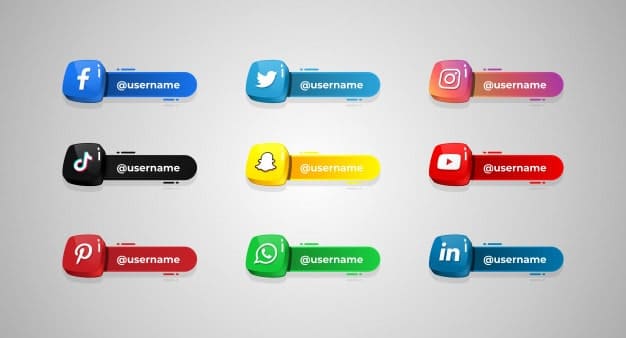In today’s digital age, modern businesses have the advantage of directly interacting with existing and potential customers from around the world. Social media platforms, specifically, provide opportunities to build and increase customer engagement – or, the emotional connection that consumers develop with a brand.
When companies successfully engage with their buyers, they are more likely to retain customer loyalty and increase sales. Not only would this enable profit growth, but it can also help with harnessing an attractive reputation and establish a competitive edge.
More and more organizations are investing time and effort into creating an online presence through social media marketing, but in order to successfully run such a campaign, it is important to understand that there are levels to this process.
Why is Social Media so Important?
Social media statistics for 2020 indicate that 3.5 billion people worldwide use SM, with Facebook being the most popular platform. This means that with just one click, retailers and restaurateurs have the capability to reach a widespread global audience.
Social media channels allow business owners to create profiles that inform customers of their services and products. It also provides opportunities to directly communicate with potential partners and/or investors.
For example, Instagram has direct messaging features that retailers can use to answer questions regarding the brand and its policies. Every account also has the ability to communicate via the commenting feature, indicating that each is active and easy to reach out to.

Additionally, online platforms allow for photo sharing, which means restaurants can post pictures of their food and menus to advertise to online viewers. Moreover, having a digital presence makes it easier for a vast network of consumers to find new businesses that have the products they want.
First Steps to Creating an Online Presence
To cultivate a strong online presence, organizations need to stand out from their competitors and present themselves as professional and inviting. Some of the first steps you should consider when making a business social media account are:
1. Decide Which Platforms You Should Use
There are a variety of social media channels, such as YouTube, Instagram, and Twitter. Depending on the business and demographics, it may be necessary to create a business profile on multiple accounts.
Having more than one platform can help with increasing customer engagement with a diverse audience. It also means that strategies must be put in place to ensure the published content fits the expectations of the website’s users.
For example, if a restaurant uses TikTok, their videos should be 60 seconds long, informative, and entertaining. However, if they are also using Instagram, one of their main focuses should be on posting aesthetic photos of their dishes.
2. Create a Recognizable Logo
To stand out from the masses, businesses need to have a logo or brand image that consumers can quickly recognize.
Creating a modern or unique logo will grab attention and help foster a positive first impression. These are effective symbols that relay a company’s identity and commitment to serve; therefore, they can enhance customer engagement.
These logos can be used as profile pictures on online accounts and can be printed menus, signage, or packaging. This will help shoppers differentiate the company from other businesses.
3. Add an Easy-to-Read Bio
On most social media sites, users can include a short bio about who they are and what they do. Organizations should add a bio and inform users about their website link, contact information, and location.
Restaurants can use this feature and add their menu to make it easier for their customers to comprehensively see the type of food they offer and their prices.
Including key information and links in a bio will drive shoppers to continue to learn more about the business and familiarize themselves with the brand.
4. Publish Content
Once accounts are made, they should be kept active with regular posts. Content should be published frequently so that audiences know that the account is active and that they can easily reach out whenever necessary.
How to Effectively Use Social Media to Boost Customer Engagement
As mentioned previously, social media marketing is beyond just creating a social media account and posting pictures. It is integral that business accounts strengthen the company’s brand awareness so that regular users are more inclined to visit the page and shop.
Some of the most effective ways to bolster customer engagement are:
• Identify Your Audience
By understanding the intended audience and their demographics, it will be easier to curate content that is relevant to their interests. It will also help with determining what platforms and brand voice to utilize.
For example, a clothing retailer with a target audience of 30 to 40-year-old women shoppers will generally have professional or witty content and tone. On the other hand, a streetwear company with a target audience of 15 to 25-year-old people would have a casual or playful brand voice.
By knowing the target consumers, businesses will know whom they are talking to, what they are interested in, and how to use content to evoke a response.
• Craft Creative and Valuable Content
It’s easy to post about the latest menu addition or newly stocked products to inform followers about what the company offers, but it is better to create content that encourages people to communicate.
Some creative ways to have followers interact with posts are using polls, asking questions, or even holding contests so that people can engage with the account. Not only would businesses boost their customer engagement doing this, but they will also receive helpful comments on what their buyers like or critiques on what they should change.
For example, a new restaurant can hold a contest on Instagram where people can sign up by following or sharing the account and commenting on their favorite menu item on a recent post.
• Use High-Quality Photos and Videos
Business profiles should be professional and content should reflect the company brand. It is important to only publish high-quality photos and videos to ensure that viewers have a positive first impression. Also, social media users are generally more inclined to follow a page that is appealing and reputable.
Having polished content will also guarantee that potential buyers can fully identify and understand what the company is selling.
• Humanize Your Business
Putting the spotlight on employees working hard and having fun can make a business appear more personable and humanizing. Business owners can also dedicate posts to talk about their purpose and values. Additionally, anecdotes about employee or customer experience can provide insight into how the business impacts people emotionally.
Creating these types of posts will show how good-natured and welcoming a business is. It also allows followers to understand and relate to the company on a deeper level, rather than it being just an establishment for goods and services.
• Use Hashtags
Hashtags on social media posts make it easier for people to find brands that are specific to a theme. For instance, if a soul food restaurant uses “#southerncomfort” or “#authenticsoulfood,” people that are scrolling through these hashtags may find the restaurant and possibly become dining guests.
Hashtags will also ensure that the post appears both on newsfeeds and search results. This will optimize viewership, as social media users will be more likely to see the post.
Businesses can also create their own branded hashtag, which customers can use and advertise on their own personal social media posts. Following the previous example, if the soul food restaurant is called Steam Kitchen, they can create #steamkitcheneats. With this hashtag, the eatery can quickly see diners who posted about their establishment.
• Have Conversations
There are two ways that businesses can actively engage with consumers. The first method is to be reactive, which means replying to direct messages, commenting on posts, or retweeting mentions on Twitter.
The second method is to be proactive and start conversations with people who are already talking about your brand online. For example, if a user on Twitter tweets, “I heard Restaurant X is finally opening in my city,” Restaurant X then has an opportunity to reply with an inviting message, grand opening details, or exclusive deals they have for interested customers.
• Schedule Content
Although it is recommended to post regularly, you do not want to flood your followers’ newsfeeds. It helps to publish content 1 to 3 times a day to show activity and to keep the profile updated. However, this depends on which platform is being used. While it is acceptable to post 10 times a day on Twitter, it may be conducive to post less on Instagram.
Also, It is important that posts are made at ideal times where most followers are online to ensure maximum audience exposure. Some social media sites will have built-in features that will inform a business account user when their followers are most active. This will help with scheduling posts at the most optimal time.
• Repost Customer’s Post
When shoppers or diners are satisfied with their service or product, they may tag the business and post on their own social media account to express their excitement. This is a form of user-generated content (UGC) and reposting their reactions is a great way to enhance engagement because it will let the original poster feel heard and recognized by the company.
It will also demonstrate to your followers that you are in touch with your customers and serve as a quick testimony of your business to other potential shoppers.
• Consistently Update Followers
Business operations are frequently changing with current COVID-19 protocols. This is apparent with restaurants and small businesses that may have to switch to curbside pick up, adjust store hours, or use online ordering.
With these circumstances, businesses should thoroughly update their followers about new procedures they are implementing and why they are making these decisions. By being open to customers and demonstrating a need for their support during these times, businesses can engage with their followers emotionally.
• Monitor Trending Topics or Events
By keeping track of the biggest news of the day, businesses can quickly hop onto the trend and generate social media engagement. For example, if the current trending topic in a local city is about the sudden cold weather (#raininla), a bakery can chime in with a post about their popular hot drinks or warm bakery items.
This form of marketing is called news-jacking and it should be done responsibly. Some tips to effectively leverage the use of trending topics are to use events that clearly relate to your brand and to publish posts promptly before the news story becomes irrelevant.
• Utilize New Social Media Features
Social media platforms are consistently updating their sites with new features, such as live streaming and online stories. It is important to keep up to date and be familiar with these new features so that you can use them to stay relevant to followers.
For instance, a restaurant can advertise their new menu items by live streaming how the dish is cooked and plated in the kitchen. They can also post stories to update their followers about the wait time and how busy their restaurant currently is.
 With many families cooking at home due to COVID-19, restaurants can also share recipes and tips on how to make their signature dishes.
With many families cooking at home due to COVID-19, restaurants can also share recipes and tips on how to make their signature dishes.
Sites like Instagram and Facebook also provide direct shopping capabilities that enable users to quickly tap and purchase items without having to be redirected to a company website. This is advantageous for retailers because they can tag their products from their shop onto their posts and drive sales through multiple avenues: social media, their website, and the physical store.
Utilizing these features can show just how in tune a business is to technology and how they can relate to their consumer base.
Conclusion
- Since there are billions of active users on social media, it has become a key part of marketing and sales strategies.
- With social media, businesses can reach a wide and diverse demographic of shoppers around the world.
- Businesses that use social media can directly interact with their customer base and build meaningful engagements.
- Having a strong online presence is integral to boosting customer engagement and businesses can cultivate this by actively using their accounts and understanding their customers’ interests.
- There are various practices that businesses can implement in their social media marketing to build relationships with buyers, promote interaction, and increase sales.







